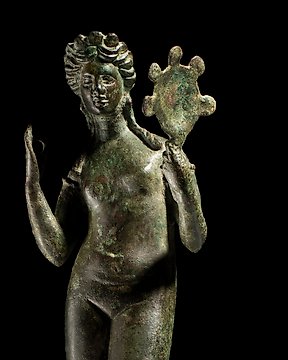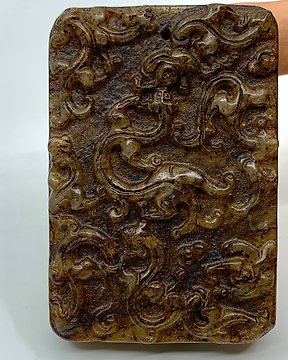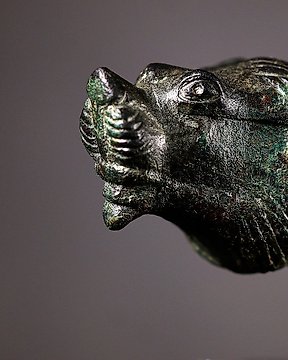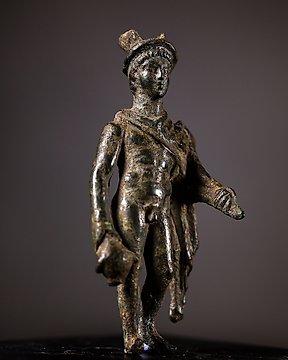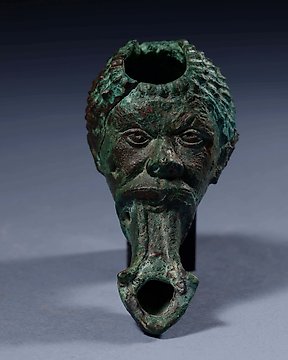Snelle en correcte levering, alleen was de verpakking voor het schilderij niet stevig genoeg.
Übersetzung ansehenIberisch Bronze Votivgabe für Männer. 4.-2. Jahrhundert v. Chr. 5,2 cm H. Spanische Exportlizenz.
Nr. 84870769
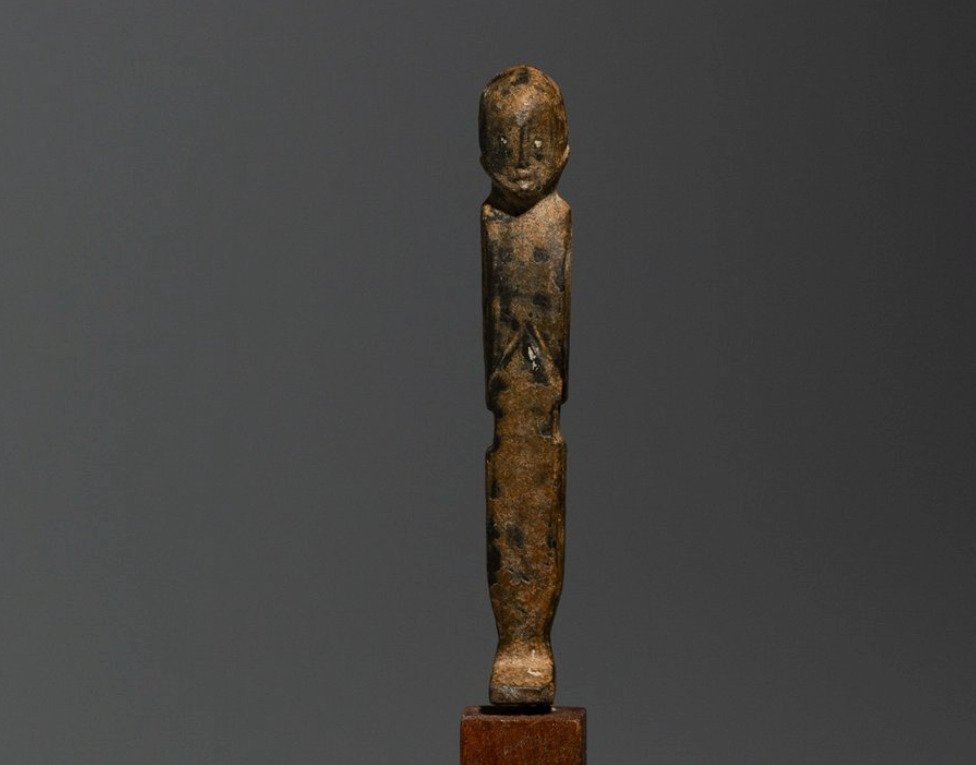
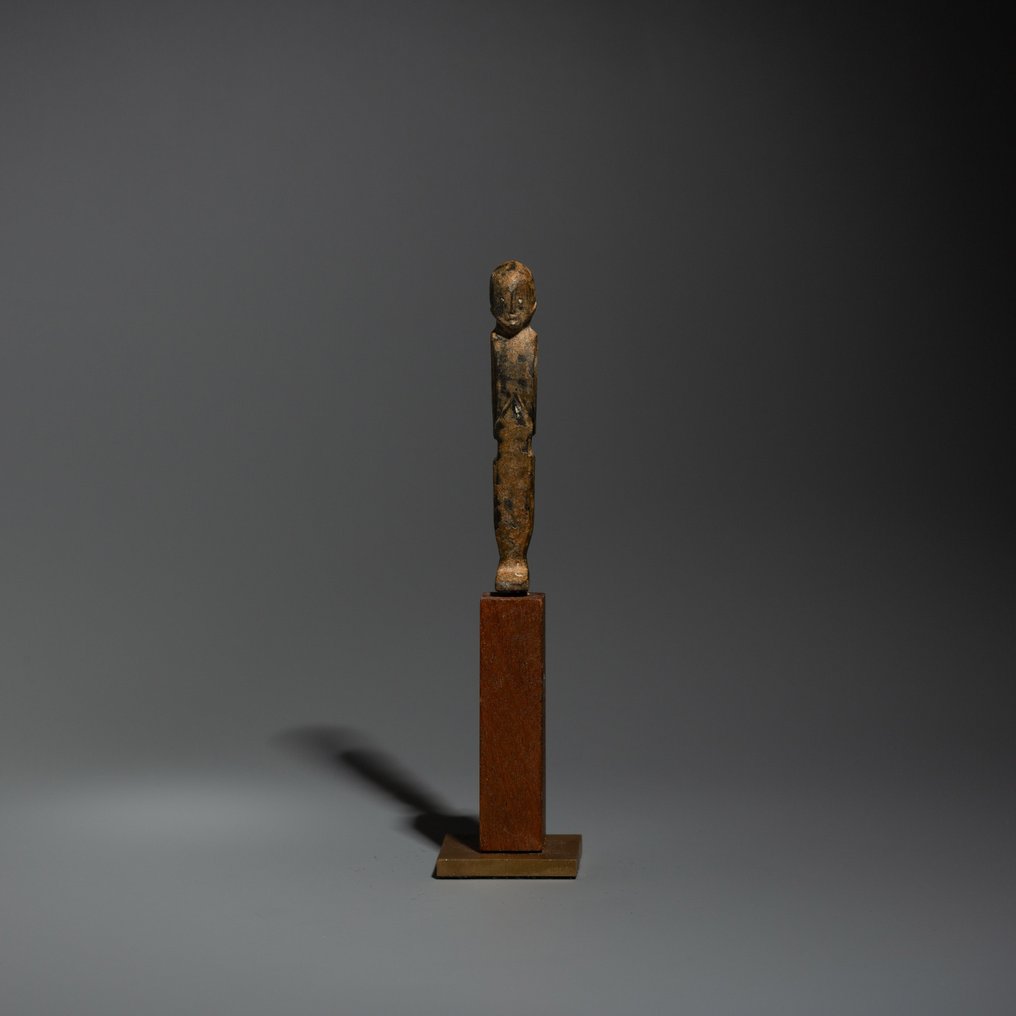

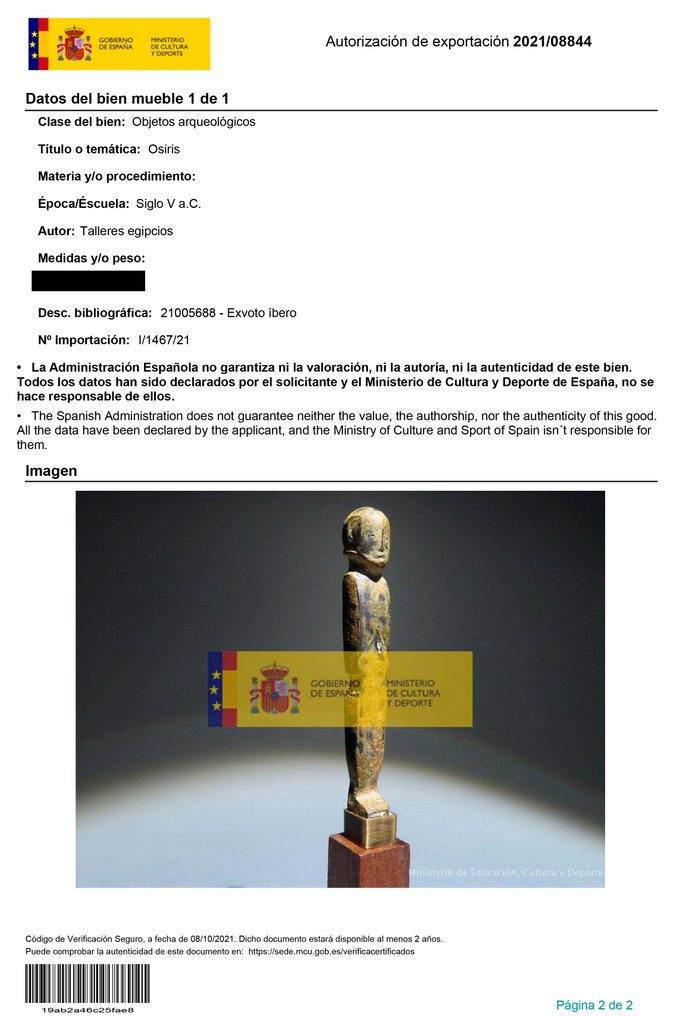
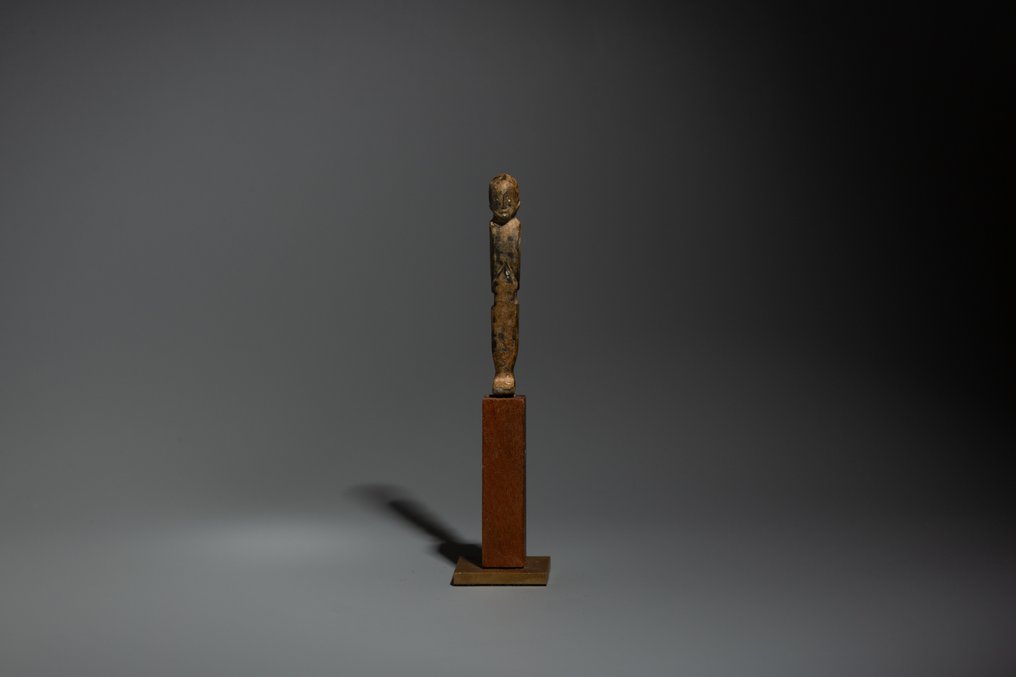
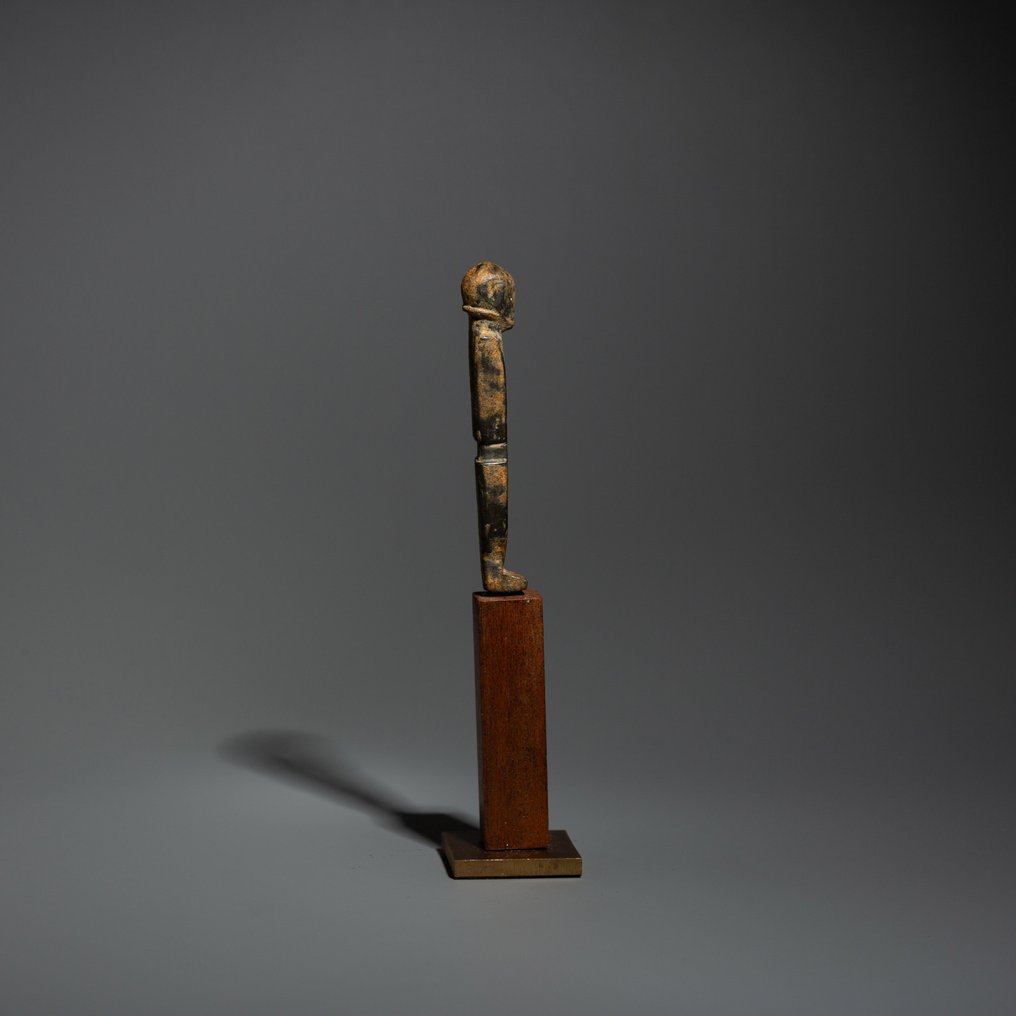
Man votive offering.
Iberian
4th -2nd century BC
Bronze
Height 5,2 cm 9,4 cm as mounted.
PROVENANCE:Private collection, Windsor, Conneticut (USA). Before in a collection fo Mr. Lewis, New York, 1991. Acquired to Atlantis Antiquities, New York, 3rd May 1991.
DOCUMENTS: Including export license from the Ministry of Culture in Spain.
CONDITION: Good condition, intact.
DESCRIPTION:
Iberian bronze round bronze votive tablet depicting a male figure in a standing position, with his legs together and his arms folded over his chest, without his elbows protruding from his profile due to the extreme synthesis of his design. The man wears a tunic with a belt and a hemispherical helmet with a wig cover, indicating that he was probably a warrior. The face is synthetic, with small eyes worked with circular incisions, a straight nose and a half-open mouth.
In the National Archaeological Museum there are several votive offerings with this same type of male figure standing, dressed, with his arms outstretched on either side of his body or in a similar position, as is the case with two examples from the collection of Carlos Walter Heiss (figs. 1 and 2).
The name Iberian refers to the human groups that inhabited the Mediterranean and southern areas of the Iberian Peninsula between the 4th century BC and the Romanisation of the area, until the 1st century BC. The Iberian culture therefore extended over a wide area stretching from Andalusia to Languedoc in southern France. It was a creative, advanced civilisation, sustained by a society organised around fortified hilltop cities, strongly hierarchical and linked by trade with the Greeks and Phoenicians.
The Iberians developed their own art, with a marked personality and, at the same time, permeable to Eastern influences, especially those of classical and Hellenistic Greece. Indissolubly linked to religion, Iberian art is related to funerary beliefs and the development of sanctuaries, which had a dual function as a sacred place and as a border marker. The interpretation of the works of art found in Iberian necropolises and sanctuaries allows us to learn about the beliefs of this people, their legends and even the personal religiosity of individuals.
Particularly noteworthy are the votive offerings, one of the most characteristic manifestations of Iberian culture, generally made in lost-wax bronze, although they have also been preserved in stone and terracotta. These are small statuettes, around 10 cm in height (the largest are no more than 25 cm), commissioned by high-ranking figures to be offered in the sanctuaries in exchange for protection, well-being, health or prosperity. In fact, most of them have been found in the cave sanctuaries of Despeñaperros, Sierra Morena and Castellar, in Jaén, as well as in La Luz, Murcia. Although they are a very heterogeneous group, they are generally stylised images of men or women in a reverential attitude, with exaggerated features or sexual organs (in the case of those related to fertility), although there are also known votive offerings representing horsemen, horses and other animals and also parts of the body, the latter related to the healing of illnesses or specific limbs.
BIBLIOGRAPHY:
- ARANEGUI GASCÓ, C. Los íberos ayer y hoy. Arqueologías y culturas. Marcial Pons Historia. 2017.
- BERMEJO TRIADO, J. Breve historia de los íberos. Nowtilus. 2010.
- PRADOS TORREIRA, L. Exvotos ibéricos de bronce del Museo Arqueológico Nacional. Ministerio de Cultura. 1992.
- QUESADA SANZ, F. “Los íberos y la cultura ibérica”, en CELESTINO PÉREZ, S., coord., La protohistoria en la Península Ibérica. Akal. 2017.
- RUEDA GALÁN, C.; HERRANZ SÁNCHEZ, A.B.; BELLÓN RUIZ, J.P., coord. Exvotos íberos. Paisajes sagrados, peregrinaciones y ritos. Universidad de Jaén. 2021.
- RUIZ, A.; MOLINOS, M. Los íberos. Análisis arqueológico de un proceso histórico. Grijalbo. 1993.
- TARRADELL, M. Arte ibérico. Polígrafa. 1968.
- VV.AA. Revista de Estudios Ibéricos. Universidad Autónoma de Madrid. 1994-1998.
PARALLELS:
Fig. 1 Male ex-voto. Spain, 4th-1st century BC. Bronze. National Archaeological Museum, Madrid, inv. 1942/100/16.
Fig. 2 Male ex-voto. Spain, 4th-1st century BC. Bronze. National Archaeological Museum, Madrid, inv. 1942/100/17.
Notes:
- The piece includes authenticity certificate.
- The piece includes Spanish Export License.
- The seller guarantees that he acquired this piece according to all national and international laws related to the ownership of cultural property. Provenance statement seen by Catawiki.
THE MINISTRY OF CULTURE FROM SPAIN ASKS ALL SELLERS FOR INVOICES OR OTHER DOCUMENTATION ABLE TO PROVE THE LEGALITY OF EACH ITEM BEFORE PROVIDING AN IMPORT OR EXPORT LICENSE.
Der Verkäufer stellt sich vor
Man votive offering.
Iberian
4th -2nd century BC
Bronze
Height 5,2 cm 9,4 cm as mounted.
PROVENANCE:Private collection, Windsor, Conneticut (USA). Before in a collection fo Mr. Lewis, New York, 1991. Acquired to Atlantis Antiquities, New York, 3rd May 1991.
DOCUMENTS: Including export license from the Ministry of Culture in Spain.
CONDITION: Good condition, intact.
DESCRIPTION:
Iberian bronze round bronze votive tablet depicting a male figure in a standing position, with his legs together and his arms folded over his chest, without his elbows protruding from his profile due to the extreme synthesis of his design. The man wears a tunic with a belt and a hemispherical helmet with a wig cover, indicating that he was probably a warrior. The face is synthetic, with small eyes worked with circular incisions, a straight nose and a half-open mouth.
In the National Archaeological Museum there are several votive offerings with this same type of male figure standing, dressed, with his arms outstretched on either side of his body or in a similar position, as is the case with two examples from the collection of Carlos Walter Heiss (figs. 1 and 2).
The name Iberian refers to the human groups that inhabited the Mediterranean and southern areas of the Iberian Peninsula between the 4th century BC and the Romanisation of the area, until the 1st century BC. The Iberian culture therefore extended over a wide area stretching from Andalusia to Languedoc in southern France. It was a creative, advanced civilisation, sustained by a society organised around fortified hilltop cities, strongly hierarchical and linked by trade with the Greeks and Phoenicians.
The Iberians developed their own art, with a marked personality and, at the same time, permeable to Eastern influences, especially those of classical and Hellenistic Greece. Indissolubly linked to religion, Iberian art is related to funerary beliefs and the development of sanctuaries, which had a dual function as a sacred place and as a border marker. The interpretation of the works of art found in Iberian necropolises and sanctuaries allows us to learn about the beliefs of this people, their legends and even the personal religiosity of individuals.
Particularly noteworthy are the votive offerings, one of the most characteristic manifestations of Iberian culture, generally made in lost-wax bronze, although they have also been preserved in stone and terracotta. These are small statuettes, around 10 cm in height (the largest are no more than 25 cm), commissioned by high-ranking figures to be offered in the sanctuaries in exchange for protection, well-being, health or prosperity. In fact, most of them have been found in the cave sanctuaries of Despeñaperros, Sierra Morena and Castellar, in Jaén, as well as in La Luz, Murcia. Although they are a very heterogeneous group, they are generally stylised images of men or women in a reverential attitude, with exaggerated features or sexual organs (in the case of those related to fertility), although there are also known votive offerings representing horsemen, horses and other animals and also parts of the body, the latter related to the healing of illnesses or specific limbs.
BIBLIOGRAPHY:
- ARANEGUI GASCÓ, C. Los íberos ayer y hoy. Arqueologías y culturas. Marcial Pons Historia. 2017.
- BERMEJO TRIADO, J. Breve historia de los íberos. Nowtilus. 2010.
- PRADOS TORREIRA, L. Exvotos ibéricos de bronce del Museo Arqueológico Nacional. Ministerio de Cultura. 1992.
- QUESADA SANZ, F. “Los íberos y la cultura ibérica”, en CELESTINO PÉREZ, S., coord., La protohistoria en la Península Ibérica. Akal. 2017.
- RUEDA GALÁN, C.; HERRANZ SÁNCHEZ, A.B.; BELLÓN RUIZ, J.P., coord. Exvotos íberos. Paisajes sagrados, peregrinaciones y ritos. Universidad de Jaén. 2021.
- RUIZ, A.; MOLINOS, M. Los íberos. Análisis arqueológico de un proceso histórico. Grijalbo. 1993.
- TARRADELL, M. Arte ibérico. Polígrafa. 1968.
- VV.AA. Revista de Estudios Ibéricos. Universidad Autónoma de Madrid. 1994-1998.
PARALLELS:
Fig. 1 Male ex-voto. Spain, 4th-1st century BC. Bronze. National Archaeological Museum, Madrid, inv. 1942/100/16.
Fig. 2 Male ex-voto. Spain, 4th-1st century BC. Bronze. National Archaeological Museum, Madrid, inv. 1942/100/17.
Notes:
- The piece includes authenticity certificate.
- The piece includes Spanish Export License.
- The seller guarantees that he acquired this piece according to all national and international laws related to the ownership of cultural property. Provenance statement seen by Catawiki.
THE MINISTRY OF CULTURE FROM SPAIN ASKS ALL SELLERS FOR INVOICES OR OTHER DOCUMENTATION ABLE TO PROVE THE LEGALITY OF EACH ITEM BEFORE PROVIDING AN IMPORT OR EXPORT LICENSE.
Der Verkäufer stellt sich vor
- 744
- 7
- 0
Herzlichen Dank!
Übersetzung ansehenAll OK and with very fast shipping.
Übersetzung ansehenPrachtig schilderij. Zo blij mee. Zeer nette verkoper en zeer snelle levering.
Übersetzung ansehenperfect ! very fast and high quality delivery !
Übersetzung ansehenAll well! Thanks.
Übersetzung ansehenVendeur très professionnel, top +++×
Übersetzung ansehenPhotos trop contrastées pour bien percevoir les défauts, mais ces défauts étaient visibles pour autant. Le "Bon état" est trompeur. Sinon, envoi rapide et correctement emballé. Frais de port exagérés.
Übersetzung ansehenGreat communication, delivery and product. Came with a well made certificate of authenticity and good packaging. Overall very happy with the purchase! Delivery is a bit expensive, but I recommend it
Übersetzung ansehenMagnifique témoin du passé, envoyé avec tous les justificatifs, impeccable. Encore une fois très satisfait, un grand merci
Übersetzung ansehenThank you for the Special offer and the fast shipping of this excellent piece of art!
Übersetzung ansehenvery good description of the object, very good price for this rare item,. Fast sending (has been at my place 2 days after buying!). Definitely would buy again.
Übersetzung ansehenSehr schön
Übersetzung ansehenAs described, perfect logistic
Übersetzung ansehengreat seller, everything came as should with certificate of authenticity
Übersetzung ansehenExceptionally well packaged, description aligned with positing received
Übersetzung ansehenReally precious, but without sound...
Übersetzung ansehenPainting well packed and rapidly sent!
Übersetzung ansehensempre grande rapidità e professionalità
Übersetzung ansehenparfait bien reçu, merci
Übersetzung ansehenVery satisfied with the small Greek Lekythos. As always (we have already bought several items from Bagot), the object was wrapped and sent immediately and with the greatest care.
Übersetzung ansehenPerfect, excellent condition, good packaging, the parcel arrived without any problems… all is perfect as usual. Thank you very much and wait for an other nice piece like this one. Gilles.
Übersetzung ansehen+++ Top vendeur professionnel comme d'habitude
Übersetzung ansehenEmbora o custo de transporte esteja acima da média foi, realmente, muito bem executado e em embalagem cuidada. Expeditos e profissionais. Recomendo
Übersetzung ansehenSnel en correct en goed verpakt verzonden
Übersetzung ansehen- 744
- 7
- 0
Snelle en correcte levering, alleen was de verpakking voor het schilderij niet stevig genoeg.
Übersetzung ansehenDisclaimer
Der Verkäufer garantiert und kann belegen, dass das Objekt legal erworben wurde. Der Verkäufer wurde von Catawiki darüber informiert, dass er die Unterlagen, die gemäß den Gesetzen und Vorschriften seines Landes erforderlich sind, zur Verfügung stellen muss. Der Verkäufer garantiert, dass er berechtigt ist, das Objekt zu verkaufen/auszuführen. Der Verkäufer wird dem Käufer alle Informationen, die zur Provenienz des Objekts vorliegen, zur Verfügung stellen. Der Verkäufer versichert, dass alle erforderlichen Genehmigungen eingeholt wurden/werden. Der Verkäufer wird den Käufer unverzüglich über etwaige Verzögerungen bei der Einholung dieser Genehmigungen informieren.
Der Verkäufer garantiert und kann belegen, dass das Objekt legal erworben wurde. Der Verkäufer wurde von Catawiki darüber informiert, dass er die Unterlagen, die gemäß den Gesetzen und Vorschriften seines Landes erforderlich sind, zur Verfügung stellen muss. Der Verkäufer garantiert, dass er berechtigt ist, das Objekt zu verkaufen/auszuführen. Der Verkäufer wird dem Käufer alle Informationen, die zur Provenienz des Objekts vorliegen, zur Verfügung stellen. Der Verkäufer versichert, dass alle erforderlichen Genehmigungen eingeholt wurden/werden. Der Verkäufer wird den Käufer unverzüglich über etwaige Verzögerungen bei der Einholung dieser Genehmigungen informieren.




